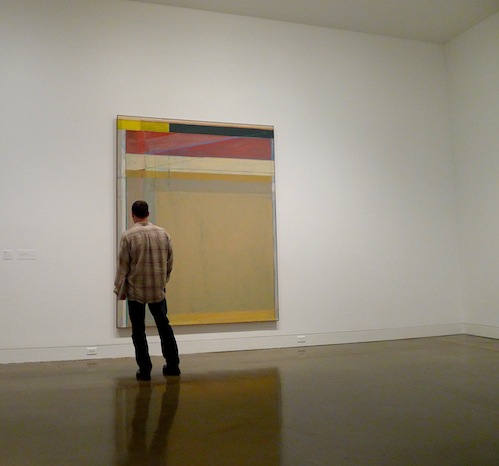It's rare to come across an Ocean Park painting in the gardens of galleries dotting our country's coasts and interiors. Rarer still is it to find more than one in a single outing. Isolated, these paintings are novelties, wanderers from that great body of work by the great Richard Diebenkorn, his crowning achievement, his masterpiece(s).
We know because we've seen them in books, salivating and wondering if we'd ever have the opportunity to see them in person. Those stragglers we find now and again are confirmations of Ocean Park's existence, but alone they only intensify the curiosity. On the page the paintings are bright, their colors played up against the intense white, and their sizes obliterated, reduced to measurements of too many inches. With only the occasional representative, the question inevitably persists: what must the others be like?
This year, for anyone with the means in Southern California, Eastern Texas, or within a reasonable radius of Washington, D.C., that curiosity was finally satisfied with Richard Diebenkorn: The Ocean Park Series, "the first major museum exhibition to explore the artist’s most celebrated series", as the Orange County Museum of Art put it.
The colors of the catalogues did not accompany these paintings into real life. Diebenkorn's reality is much more subdued and contemplative. The paintings, as we know, fill walls, but less well known is that many fill mere inches. With rooms and rooms of Ocean Park, each piece was no longer a memento, but a full fledged force to behold — or by which to be held, turned, pushed. There is no monolithic Ocean Park, not in size or palette or medium. With uncommon authority, each canvass — or collage, or etching, or cigar box lid — directs you in its own way and offers its own unique rewards.
One long held measure of a painting's effectiveness has been its ability to function both up close and at a distance. The painting, it is said, should excite the eye no matter what the proximity. Surprisingly however, many of these works do no such thing, and interestingly manage to in no way fall short. While most paintings that draw you in and prove wanting only disappoint, Diebenkorn's seem simply to say to you, 'No no, go stand over there,' as though there is an optimal viewing range for every piece, and each will let you know in turn what that position is.
In this way the paintings upend the common notion of "push and pull" which generally refers to the illusion of space within a painting. At the Orange County Museum, the push and pull was of the visitor, paintings tugging you in from other rooms, pressing you into oblique viewing angles, pulling you right up to the layered surfaces, and pushing you back when you got too close.
What's more, for all the buzz around their landscape inspiration — some have mentioned overhead views of farmland in addition the Ocean Park neighborhood itself — there isn't much space in these paintings. Diebenkorn seems to keep colors flat precisely to prevent them from competing for depth. Thus, a mark that's technically over can be through, as in Ocean Park #54, in which an opaque blue line pushes its way through a same blue scumbling. The interplay here is between millimeters, not miles, for as with much of the artist's work, what each piece reveals more than anything else is the process of its own making.
The what of that process was of course Diebenkorn's constant revision. A layer of yellow over red, washes of pink and blue and green resolving finally to a beige rose, lines that intersect and intertwine and flow from here to there all to tie that end of the surface to this one. Diebenkorn could let flecks of paint fly as well as Cy Twombly and may have given more attention to edges than Piet Mondrian. Asked once whether he had ever let a particular group of paintings out of his studio, the artist replied, "These? No, no, they're not done. Or, they're sort of cooking." For Diebenkorn there was no recipe to follow; he just had to keep tasting to see if he'd gotten the balance of flavors right.
There has been no shortage of praise for this traveling one man show. The widely known but little conglomerated series stands as a capstone to what was already an impressive artistic career. The Dallas Morning News referred in its review to Diebenkorn's "Southern California sublime"; The LA Times called the show one "you might have wanted to see but that you didn't know you really had to see -- until you [saw] it," (italics added); and The Washington Post billed the exhibition as "a large, dense, rewarding show devoted to one of this country’s finest abstract painters." The greatest praise may have come from critic Mat Gleason, writing for The Huffington Post, who declared, "If you miss this one, you are just not into art." Gleason's elaboration on this statement highlights the semi-elitist assholeishness of much of the art world, but the fact remains, the exhibition was really quite good.
So while it may not be particularly impressive to top the list of someone whose obligations over the past months prevented much in the way of far reaching art viewing, I've little doubt this series would have been the jewel in the crown of any good year.





